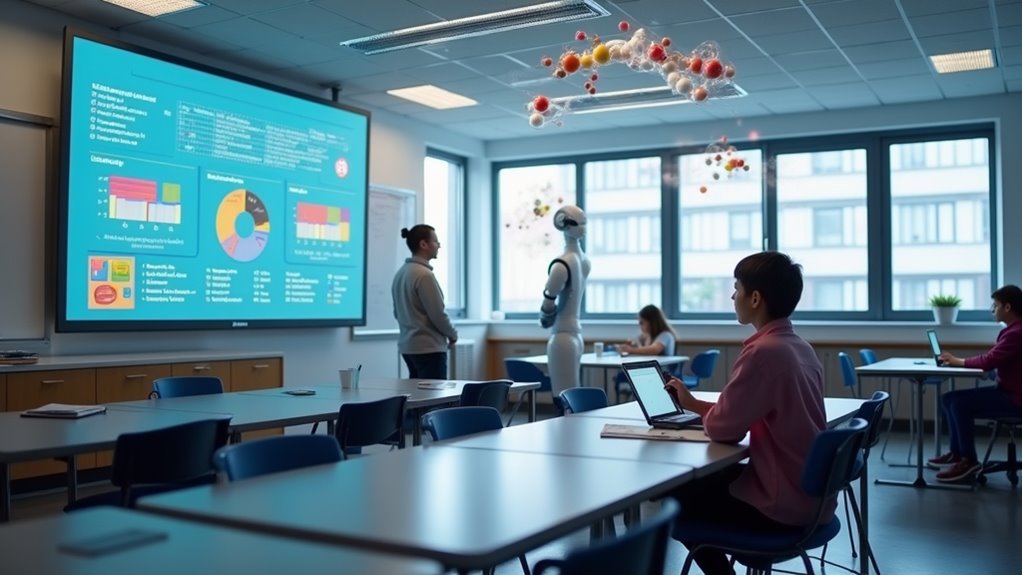AI is revolutionizing education through personalized learning experiences tailored to individual students’ needs. It’s automating tasks like grading (saving teachers 70% of assessment time) while offering 24/7 support to learners. Though 86% of students already use AI tools academically, many feel unprepared—like getting car keys without driving lessons. The technology risks widening achievement gaps between resource-rich and under-resourced schools. Proper implementation guarantees AI becomes an equalizer rather than another digital divide.

Artificial intelligence is revolutionizing classrooms across the globe, transforming how students learn and teachers teach. As AI tools become more prevalent, questions about AI ethics and educational equity take center stage. Will all students benefit equally? Not if current trends continue. Schools with greater resources often implement advanced AI systems first, potentially widening achievement gaps. The technology itself isn’t biased, but its distribution certainly can be. Every student deserves access to these powerful learning tools, regardless of zip code or family income.
Today’s students are already embracing AI, with a striking 86% using tools like ChatGPT for academic purposes. On average, students juggle 2.1 different AI applications for research, writing, and studying. Yet many feel unprepared to use these tools effectively. It’s like handing someone keys to a car without driving lessons—powerful but potentially problematic.
The efficiency gains are undeniable. AI-powered grading systems like Gradescope slash assessment time by 70%, freeing teachers to do what they do best: teach. Meanwhile, students receive instant, consistent feedback that helps them correct course before small misunderstandings become major obstacles. Similar to business applications, machine learning algorithms can identify patterns in student performance data that human educators might miss, offering deeper insights into learning progression.
Personalization represents perhaps the most promising aspect of educational AI. These systems track individual progress, adjusting difficulty in real-time to keep students challenged but not overwhelmed. When a platform detects a student struggling with fractions, it doesn’t move on to decimals—it provides targeted support exactly when needed. The integration of natural language processing technologies has significantly enhanced these personalized learning experiences, allowing for more intuitive interactions between students and educational software.
Virtual learning environments enhanced by AI make education more accessible for diverse learners, including those with disabilities or geographic limitations. The technology adapts to different learning styles, presenting visual materials for some students and text-based resources for others. These environments require careful consideration of data privacy concerns as they collect extensive student information to function effectively.
Looking ahead, AI will increasingly function as a personalized learning companion, available 24/7 to answer questions and provide guidance. Virtual assistants will evolve beyond simple queries to become sophisticated educational partners. The classroom of tomorrow won’t just incorporate AI—it will be fundamentally shaped by it.
Frequently Asked Questions
Will AI Replace Teachers in the Classroom?
AI won’t completely replace teachers in the classroom.
While AI can automate about 30% of teaching tasks and offer personalized learning experiences, it can’t replicate human connection and empathy.
Teacher roles will evolve, not disappear.
Classroom dynamics will shift toward more mentoring and targeted instruction as AI handles administrative burdens.
The future isn’t robot instructors—it’s a partnership where technology handles the mundane, freeing teachers to do what matters most: connecting with students.
How Can Schools Ensure Equitable AI Access?
Schools must tackle the digital divide head-on to guarantee equitable AI access.
First, they should conduct needs assessments—who’s got what?—then strategically allocate resources where they’re most needed.
Providing school-owned devices, subsidized internet connections, and dedicated AI tool subscriptions isn’t just nice—it’s necessary.
Creating tech lending libraries and establishing public-private partnerships can stretch limited budgets.
Can AI Detect Student Cheating Effectively?
AI’s cheating detection capabilities are impressive but imperfect. Current tools boast high accuracy rates—some claiming 99.9%—in identifying AI-generated content, supporting academic integrity efforts.
However, clever students can circumvent these systems through paraphrasing or using alternative tools. Rather than solely relying on detection technology, educators are finding better success combining these tools with thoughtful assignment design and promoting ethical AI use.
The battle between cheating technology and detection methods continues to evolve, with neither side claiming complete victory.
Are There Privacy Concerns With Educational AI?
Educational AI raises significant privacy concerns.
Student data collection is extensive, often without clear consent policies. Schools gather behavioral patterns, academic performance, and even biometric information.
Who’s protecting all this data? Data security measures frequently lag behind collection capabilities, creating vulnerability.
Students’ digital footprints become permanent records that could follow them indefinitely.
While AI promises personalized learning, the privacy trade-off demands scrutiny.
Without transparent boundaries, educational AI risks becoming surveillance rather than support.
What Skills Should Students Develop Alongside AI Tools?
Students need to develop critical thinking skills that AI simply can’t replace.
While machines crunch data, humans must evaluate that information thoughtfully. Creative problem solving becomes essential—because let’s face it, AI follows patterns while innovation requires thinking outside the algorithm.
Other vital skills include digital literacy, ethical reasoning, and effective communication.









